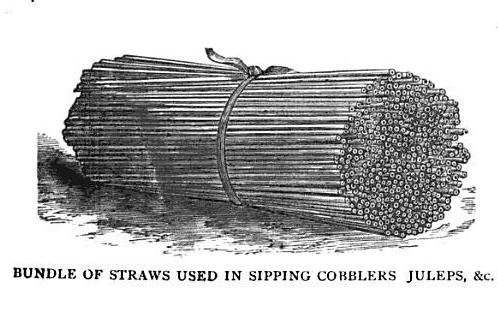
“The very act of imbibition through a straw prevents the gluttonous absorption of large and baneful quantities of drink….”
Supposedly, the nineteenth century’s popular mixed drink, the gin sling, was named on the German “schlingen”–as in schlingin’ back a drink. The 1868 Cook’s Guide Gin-Sling recipe might back that theory, or refute it, depending on how you look at it. On advising the imbiber to “suck through a straw,” the author follows with a humorous apology:
I am afraid that very genteel persons will be exceeding shocked at the words ‘suck through a straw;” but when I tell them that the very act of imbibition through a straw prevents the gluttonous absorption of large and baneful quantities of drink, they will, I make no doubt, accept the vulgar precept for the sake of its protection against sudden inebriety.
Nineteenth-century straws were usually literally straw, or rye grass, sometimes glass or metal. Ohio Civil War veteran and julep-drinker Marvin Stone may or may not have actually invented the paper straw, but he was the one who, in 1888, patented the paper-spiralling process used for mass-manufacture.
An 1873 New York Times article, “American Drinks at the Vienna Exhibition,” gives the lie to straws slowing drinkers down (though it gives them the character of “refined”):
The straws are immensely popular here. I have seen persons of both sexes sucking up beer, coffee and ‘plain soda’ through them with an evident sense of exquisite and refined enjoyment. The bar-keepers tell me that the American and German ladies generally carry them away in their hair, through the frizzy masses of which they stick them in the manner of pins. The bar in the Rotunda started with a stock of 300,000, but has been obliged to renew its supplies twice since commencing business.
“American Drinks” were what we generally call cocktails today. A tentative guess at why they were labeled “American” is that they were iced, and until the past couple of decades, ice in drinks was virtually nonexistent in Europe. Straws and “American drinks” go well together, since straws ease the passage of drink through ice to mouth.
Sources: The Cook’s Guide, by Charles Elme Francatelli, London 1868 | New York Times September 2, 1873, via Boulder Libation |
Hi Jean,
This is just a note to compliment you on your appealing website. I found you through your article on Goodreads and had to click on the link. From your ‘links’ and tags I see we share many interests and interests in time periods.
My ancestors lived and fought the civil war in Texas, Mississippi, and Lousiana and I am fascinated by early Medieval, 18th century, Civil War, and Americana history and historical fiction.
I especially appreciate your professionalism and experience as displayed by your layout.
Good work,
Steve
Thanks, Steve, glad you’re enjoying Leaves of Grass. Come back any time, or since I don’t post as regularly as I ought, you may wish to subscribe via email (at right).
Pingback:Building the Straw Monster – Vivre Zero Waste